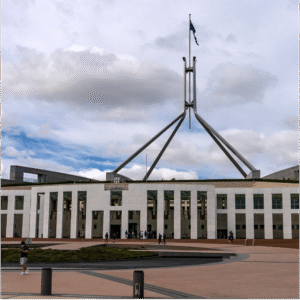16-year-old Noa Gomberg explains Australia’s voting system ahead of the election in May
April 18, 2025
Everything young voters need to know about 2025 Australian elections
Australia’s next federal election will be held on Saturday 3 May. This article explains how the voting process works, why it matters, and what young Australians think about the current voting age. There’s more information on the Australian Electoral Commission’s website.
Harbingers’ Weekly Brief
What is the Australian federal election?
The federal election determines Australia’s governing political party and senators for the next three years. They determine policies on the economy, education, healthcare and community safety, among other things.
How does the Australian Parliament work?
The Australian Federal Parliament has two houses, the House of Representatives (lower house) and the Senate (upper house). For a party to form the government, it must have the majority of seats in the lower house.
The House of Reps, as it’s known, represents the Australian population, with the states and territories being divided into electoral districts. Voters in each district vote for a Member of Parliament (MP) to represent them in the House; currently there are 151 MPs, elected for a three-year term.
The Senate represents the interests of the states and territories. There are 76 senators in total, twelve from each of the six states and two from the two mainland territories. They are elected for a period of six years, with half the Senate retiring every three years.
How does the voting system work?
Australia uses preferential voting. This means that voters rank candidates for the House of Representatives in order of preference. If a candidate gains an absolute majority (more than 50%) of first-preference votes, they are elected. Otherwise, the candidate with the least votes is eliminated, and their votes are redistributed according to second preference until a candidate has more than 50% of the votes.
For the Senate, voters can either rank their preferred political parties or individually number candidates. A quota is calculated, with senators who reach it being elected and excess votes from elected senators being redistributed.
Is voting compulsory?
Yes, Australia is one of the few countries in the world where voting is compulsory. If you are an Australian citizen aged 18 or above, you must enrol and vote in every election (state and federal) and referendum. Not voting may result in a (small) fine.
Which parties are in the race?
The major players are the Australian Labor Party (centre left) – currently in government and led by prime minister Anthony Albanese – and the Liberal-National Coalition (centre right), led by Peter Dutton. There are also the Greens (left), and various independents who have their own political ideologies.
What are they promising young voters?
The Coalition – currently leading in the polls – says it will make homes more affordable for young, first-time buyers by boosting the economy and investing in security to create safer communities.
The ruling Labor Party, if re-elected, plans on strengthening Medicare, Australia’s free medical system, and cutting student debt by 20%. This is particularly popular among young people, whose main barrier to tertiary education is university fees.
The Greens pledge to take stronger climate action and tax billionaires.
What is the voting age?
Even though teenagers can pay taxes from the age of 15 and are affected by elections, they can’t vote because Australia’s voting age is 18. This has left many young Australians feeling disenfranchised and has led to the rise of campaigns such as Make It 16 and Forfeit.
The Make It 16 campaign, which started in 2023, calls on the government to lower the legal voting age from 18 to 16.
The Forfeit Campaign – powered by the social enterprise Raise Our Voice – asks those eligible to vote in the upcoming election to symbolically “forfeit” their vote. In this context, forfeiting means using their vote to represent the interests of young people. Raise Our Voice asks young people to share the issues that matter to them and the actions they would like to see, which will then be relayed to voters.
Written by:

The Harbinger Prize 2024 (Women’s Desk)
Writer
Melbourne, Australia
Noa was born in 2008 in Rio de Janeiro, Brazil, and moved to Australia at the age of nine, where she currently studies. She is passionate about books, history, science, fiction and poetry writing, and social media, with plans to study Politics and Law in the future.
She joined Harbingers’ Magazine in 2024 after winning the Women’s Desk category of the Harbingers’ Prize, writing about current affairs, history, and pop culture. After successfully completing the Essential Journalism course, Noa became a writer for the magazine starting in March 2025.
In her free time, she enjoys writing short stories, poems, and arguing over dinner.
Noa speaks Portuguese and English.
Edited by:

🌍 Join the World's Youngest Newsroom—Create a Free Account
Sign up to save your favourite articles, get personalised recommendations, and stay informed about stories that Gen Z worldwide actually care about. Plus, subscribe to our newsletter for the latest stories delivered straight to your inbox. 📲
© 2025 The Oxford School for the Future of Journalism



